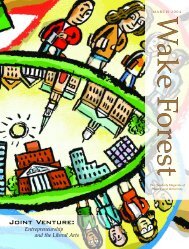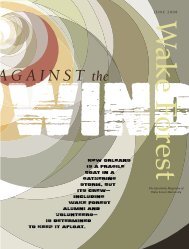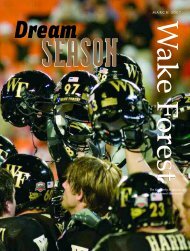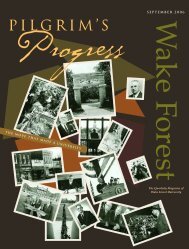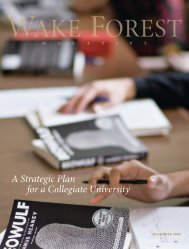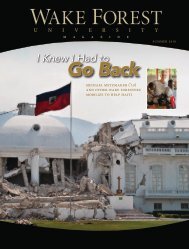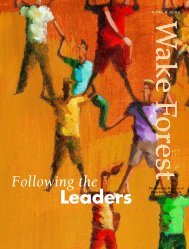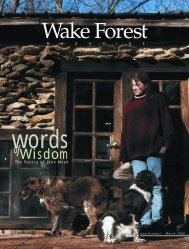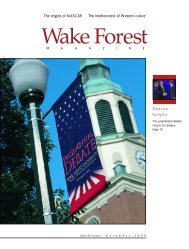Wake Forest Magazine September 2003 - Past Issues - Wake Forest ...
Wake Forest Magazine September 2003 - Past Issues - Wake Forest ...
Wake Forest Magazine September 2003 - Past Issues - Wake Forest ...
Create successful ePaper yourself
Turn your PDF publications into a flip-book with our unique Google optimized e-Paper software.
EssayOur TownOff Highway1, an adventure in preservationBy Gene CappsTake busy U.S. Highway 1 and drive northfrom downtown Raleigh. For almost half an hour youpass through a concrete and glass mosaic of shoppingcenters, car dealerships, and restaurants. Once beyondthe second outer loop of North Carolina’s growingcapital city, the landscape of suburban sprawl quicklychanges. Ragged expanses of tall pines and younghardwoods stand like bastions, but these forests belie acertain future already evident in thousands of newhouses, condominiums, and apartments tucked amongthe wooded landscape. Even one of the state’s naturaltreasures, the Neuse River, which only a few years agoseemed to be in the heart of country, is now beingencroached by urbanization.Just beyond the Neuse, amid what was once knownas the <strong>Forest</strong> of <strong>Wake</strong>, a right turn off Highway 1 leadsyou into the town of <strong>Wake</strong> <strong>Forest</strong>. Incorporated in1909,but dating back to the beginning of <strong>Wake</strong> <strong>Forest</strong>Institute in the 1830s, the historical community nowfinds itself abutting Raleigh’s expanding city limits.Driving into its heart, however, the small communitylooks more like a town from the 1960s than a suburbof its sprawling sister to the south. Buildings dating tothe turn of the 20th century visually dominate its centralbusiness area along White Street, which doglegsaround the site of a former town well.Two constants from <strong>Wake</strong> <strong>Forest</strong>’s past remaindowntown. Renowned Shorty’s, now operated byMillard “Shorty” Joyner’s nephew, has kept its eclecticatmosphere and basic menu, but without the fifteencenthotdogs of yesterday.The train that runs along theold Raleigh and Gaston Railroad continues to rattlenoisily back and forth behind the sandwich shop eventhough it no longer stops as it did for decades to pickup and unload students, mail, and freight. Gone fromdowntown, however, are the <strong>Forest</strong> Theater, Holding DrugStore and Company, Bolus Clothing Store, Pope’s, Macks Fiveand Dime, and many other establishments that once servedgenerations of <strong>Wake</strong> <strong>Forest</strong> students and townspeople.WhiteStreet now has a computer shop, a hardware store, a bank, adance studio, and offices, but for the most part it is a street dominatedby small gift boutiques, specialty shops, and restaurants.The old <strong>Wake</strong> <strong>Forest</strong> campus is as handsome as it was a halfcentury ago.The rock wall built by former bondsman TomJefferies, part of President Charles Taylor’s efforts to turn thecampus from a pasture into a park at the end of the 19th century,continues to define the main academic space. Statelymagnolias and hardwood trees thrive. Beautiful Lea Laboratoryhas been restored and is on the National Register of HistoricPlaces.The elegant yet straightforward Georgian architecturalstyle that was introduced with the construction of the firstcollege building still dominates the campus. Even though theSoutheastern Baptist Seminary has removed four of the oldbuildings and built four new ones, in many ways the campusseems unaffected by the passing decades.Large Victorian homes and picturesque cottages still punctuateneighborhoods near the campus. Life in old <strong>Wake</strong> <strong>Forest</strong>was a careful blending of gown and town, and that amalgam isillustrated in these historical residential areas. At one timeprofessors and businessmen and their families lived side byside in houses that were often homes to countless boardingstudents as well. A few of the houses remain in the hands ofdeeply rooted <strong>Wake</strong> <strong>Forest</strong> families, like President Taylor’sgreat grandson A.C. Hall, but most have been bought andlovingly maintained by newcomers, some of whom commuteto jobs throughout the Triangle.The North Main Street area,designated one of North Carolina’s first historic districts in1979,attracts a steady flow of runners and walkers, young andold, along its tree-shaded sidewalks. Some patriarchs from <strong>Wake</strong><strong>Forest</strong> history lived on this thoroughfare, men like Samuel Wait,38 <strong>Wake</strong> <strong>Forest</strong> <strong>Magazine</strong>



